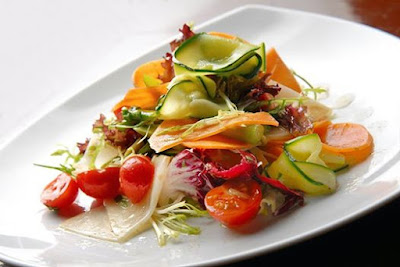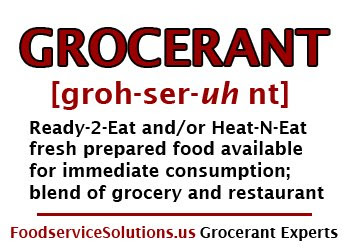It is at the
intersection of fresh food fast and customer service that full flavored food
meets technology and once in a while there is simply to much technology for
customers to make a connection with you brand according to Steven Johnson
Grocerant Guru® at Tacoma, WA based Foodservice Solutions®.
Recently Brian Duncan,
President of me&u USA talked about an evolving trend in customers
preferring more human interactions in restaurants, causing a decline in the use
of QR codes. He found:
1. 81% of consumers feel
that human interaction is the most important factor in restaurants and bars.
2.
QR code scans in
restaurants have decreased by 27% in
a year.
3. 88% of diners prefer
paper menus to digital QR
codes.
4.
49% of
consumers are more likely to visit restaurants that use technology to give
them a personalized menu that’s unique and tailored to their
preferences.
5.
66% of
consumers prefer to use a food service app that allows them to split
the bill easily amongst themselves.
Duncan continued “The
need to customize experiences for each individual visitor has become
increasingly important for restaurants,” , who have introduced their latest feature – me&u
Flex – a scan, order, pay technology that delivers convenience without
sacrificing human interaction.
That said, the Gorcerant
Guru® believes that grocery
stores could give restaurants a run for their money through the continued
growth of retail foodservice. That was a key theme of the keynote presentation at
the recent 2023 International Dairy Deli Bakery Association (IDDBA) conference
in Anaheim, California.
IDDBA
Vice President of Marketing Whitney Atkins and Heather Prach, the association's
VP of education, which highlighted trends and areas of opportunity in the
industry.
Prach
noted in the presentation that home delivery and e-commerce have been
“difficult for our categories to execute in retail” but they’re well worth the
investment. A survey of consumers showed that 62% occasionally order restaurant
delivery, compared to 33% for grocery prepared foods delivery. The results were
similar for restaurant takeout at 78% versus grocery deli-prepared takeout at
41%.
“There’s
a bit of margin lost with the delivery services, but 46% of shoppers are
wanting that option, so maximizing the e-commerce platform to give recipes,
meal solutions and meal planning within the platform can be ways to increase
sales,” Prach said.
She
noted that sandwich sales, particularly peanut butter and jelly components, are
up but could go much further with indulgent upgrades. Prach advised showing the
full sandwich and meal pricing within the departments, as a way to illustrate
the value and savings available to shoppers compared to their quick-serve
restaurant counterparts.
“There’s
also room here to upgrade sandwiches to fresh-baked bread in the deli or a
small indulgence upgrade to brioche bread or to a bagel or a croissant, etc.,”
she added.
Prach
noted that the “on-the-go lifestyle” has returned with many workers returning
to the office, adding that “Feeding the family has become a balancing act
between money, health, taste and time.”
There’s
not a single shopper that always saves money, always shops for health-forward
foods or always shops for new over nostalgia. Convenience at the right time for
the customer is key. A great example of this is pizza, she said. Pizza can be
sold ready to eat, it can be sold ready to bake, frozen or as its individual,
from-scratch components. It's a customizable product that can serve a variety
of consumer need states.
“Home
cooking burnout fuels this trend,” she said. “It is exhausting to keep a
rotating menu at home and to cook every meal every day.”
Prach
noted that most households maintain a “hybrid system” of cooking, which
involves weekly meal planning, subscription plans for home cooking and buying
premade meals and sides to support parts of the meal. Forty-one percent of
shoppers are cooking mostly from scratch, while 50% mix homemade meals with
semi- and fully prepared items, she added. “These items can be from the deli
along with produce and meat,” Prach said, noting that currently, only about 9%
are mostly shopping for fully prepared items.
“Shoppers
want convenience as an option, and this is led by our grab-and-go. Fifty-five
percent of shoppers want easier shopping in the grab-and-go, so make sure these
items are stocked throughout the day and night,” she said. “Shoppers may be
thinking of future meals while they’re in the store.”
Grocers
can capture more spend from morning grab-and-go shoppers who may already be
thinking of lunch and dinner for later while in the store. Similarly, later
shoppers “want to know that their local retailer will have a reliable selection
of grab-and-go along with easier preparation items that they can quickly heat
and serve no matter what time.”
Prach
added that quick breakfast items, especially in the bakery, have seen huge
growth since 2020. “Donuts, croissants, pastries, muffins have all grown,” she
said. “Some shifts from being home have built habits and taught people how to
save. Having a quick piece of bakery and brewing coffee at home can save time
and still feel indulgent.”
Foodservice Solutions® team is here to
help you drive top line sales and bottom-line profits. Are you looking
a customer ahead? Visit GrocerantGuru.com for more information or contact: Steve@FoodserviceSolutions.us Remember success does leave clues and we just may the clue
you need to propel your continued success.






No comments:
Post a Comment